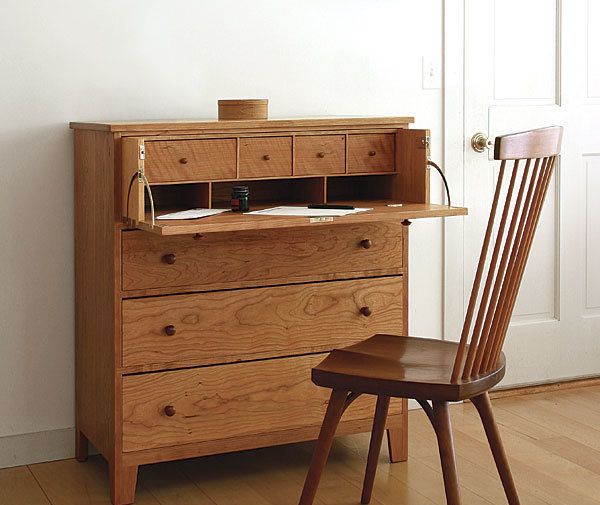Build a Desk in a Drawer
Add a pull-out desk to any chest of drawers.

Synopsis: The top drawer of this bureau is what’s known as a “butler’s desk,” a Shaker design where a writing surface and cubbyholes are discreetly hidden behind what looks like a drawer front. This particular design can be adapted to fit into a traditionally built bureau of any type. The case and its lower three drawers are constructed just like a standard chest of drawers. The desk drawer, however, is a departure. In this article, Christian Becksvoort walks you through the steps needed to orient the parts correctly, add the dividers, and install the hardware.
Of all the desks the Shakers built, perhaps the rarest is the butler’s desk, a bureau whose top drawer is actually a fall front that pulls out and opens to reveal a gallery with smaller drawers. The idea of discreetly fitting a writing desk into a chest of drawers did not originate with the Shakers—butler’s desks have been made in many styles over the years, notably in campaign furniture and for shipboard use—and the desk drawer I’m making here could be fitted to a traditionally built bureau of virtually any design.
The bureau’s case and its lower three drawers are constructed just like a standard Shaker chest of drawers (for details of such a chest, see “Cherry Chest of Drawers,” FWW #170). The desk drawer, however, is a departure. Like the other drawers, the desk is a dovetailed box, but it’s beefier and has been turned so that its “bottom” is at the back. Because the desk drawer is built this way, it can be sized to fit snugly into the drawer opening—no allowance is necessary for expansion and contraction in the height or width of the drawer box. The desk drawer’s fall front, however, with its grain running side-to-side like the other drawer fronts, must be sized with wood movement in mind.
Build the case first so that you’ll be able to size the desk drawer precisely to its pocket. The desk drawer, made with 3⁄4-in.-thick stock for the sides and bottom, and 1⁄2-in. stock for the top, is through-dovetailed on all four corners. The back panel floats in a groove. With the dovetails cut, dry-fit the four sides of the drawer box, and machine the rabbet for the fall front.
The bottom of the fall front and the front edge of the drawer box have mating rabbets that allow the fall front, when lying flat, to meet the bottom of the drawer box without a gap, yet still fill the whole drawer opening when upright. I cut both rabbets on the tablesaw. Together, the depth of the two rabbets must equal 3⁄4 in. I made the rabbet in the drawer box the shallower of the two to leave more purchase for the hinge screws located above it.
For the full article, download the PDF below.
Fine Woodworking Recommended Products

Dubuque Clamp Works Bar Clamps - 4 pack

Stanley Powerlock 16-ft. tape measure








Comments
What about that chair? Are there drawings or plans available for the spindle-back chair pictured with the chest?
It's a Thos. Moser chair. Becksvoort worked with him early on. Moser's book(s) have plans for the chair.
Log in or create an account to post a comment.
Sign up Log in